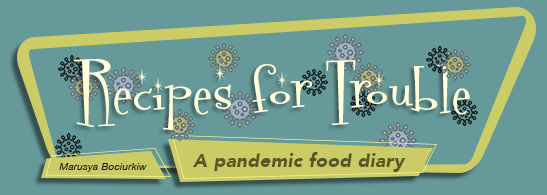A Shopping Trip, and the Norway Cemetery
Shopping and cooking have acquired intense meaning during the pandemic, a way to make sense of a turbulent world. This is the first in a series I’m writing, using food and foodways as a way to write about and understand my own experience of the pandemic and connect it to local and global issues.
On a pellucid, breezy summer day, I head to what I call “The Tiny Carrot”, a far flung, and much smaller outpost of “The Big Carrot”, (a popular Toronto whole foods store). The ride there takes me past and through the St John’s Norway Cemetery, a 160-year-old interfaith graveyard and crematorium spanning 35 acres in Toronto’s east end. Its uneven landscape is ornamented with thousands of grey headstones, mature trees bowing crookedly over them. The cemetery appears to be closed due to COVID, but I know a secret entrance. The entire, macabre park, as I cycle along steep hills smelling of mown grass and trees, is mine. I find out later that the cemetery is named after the village that this neighbourhood used to be, and that the village, in turn, was named after the Norway pines that surrounded it. It seems apt, somehow, that a handful of B-grade movies have been filmed there, including Gus Van Sant’s 1995 To Die For, starring Nicole Kidman.
I park my bike and stroll through the graveyard’s shady, sepulchural expanse. I notice most of the names are Anglo-Saxon, and probably white. This is because segregation of schools, restaurants, and cinemas and even cemeteries existed officially in Ontario until the mid-sixties. In Nova Scotia, Black people weren’t even allowed to be buried alongside white people, and were interred on the outskirts of graveyards. Racialized bodies were disposed of randomly and mercilessly, and sometimes became landfill. Leslie Spit holds many such anonymized remains. Black pioneers’ graves in Priceville cemetery, north of Toronto, were plowed over by a white farmer who then planted potatoes there (see the NFB film Speakers for the Dead, for more on this story).

I return to my errand. I’m willing to travel far to be safe; this store cares for the safety of its customers. It’s congenial, too. The workers glance up brightly, as though expecting me, seemingly delighted to see someone make the trek to their organic Siberia. I buy chicken, and rice cakes and blueberries. The employee who stands at the door to let people in, is dancing to the soft rock playing on the sound system. He asks me how I’m doing. I’m OK but I’m tired of all this I say, motioning to my mask and gloves. I know it, he says. It’s the only real life conversation I’ve had all day.
Coming home, a particular pandemic-Sunday gloom descends on me. Families strut down the middle of the street like geese; couples seem turned inward, hands glued together like wedding cake statues. In times of scarcity, new forms of capital appear. A random memory of my father surfaces. He used to tell us the story of how, as a prisoner of war, he used drawings as a form of capital, to get more food. Touch is capital, now. “Normally”, as we used to say, the Sunday – gloom would dissipate, with rendezvous with a friend, an evening rubbing shoulders (as we used to say) at the film festival, or at the gay theatre. As I glance at the calendar, I realize I’d be at an academic conference this weekend, in London. (London Ontario, not UK, but still).
I sit with loneliness, trying to focus on feeling, not thought; to make the thinking go away with breath; to regard the feeling, so closely that, like a pixelated photograph, its features disappear, and become more generalized. I sit with grief, too. The loss of my mother, eight years gone, almost parallel to the 10 years I had with her after we’d reconciled. I’m glad she’s not here to witness this.
I can’t stop thinking about the police murder of a 29-year-old woman, Regis Korchinski-Paquet, in my city. I discover that alongside her Indigenous and Black identities, she was also of Ukrainian descent, and learned Ukrainian dancing as a kid, just like my brothers and my niece. She called her grandfather Dido, just like I did. Her funeral was held at The Holy Eucharist Ukrainian Church on Broadview Avenue. I took my Mom there, once. Her Dido was a priest, there.

There was grief among the thousands of us that gathered that week, in the closest physical contact most of us had had in months. Anger, too, in protests against police violence around the world. The reassuring yet disturbing proximity of bodies; the looming fear of infection. “If we end police violence,” said a friend run into at the march, “it will be worth it.” The fatalism in those words. But Maimuna Majumder, a computational epidemiologist at Boston Children’s Hospital and Harvard Medical School argues, “I personally believe that these particular protests—which demand justice for black and brown bodies that have been brutalized by the police—are a necessary action,” she said. “Structural racism has been a public-health crisis for much longer than the pandemic has.”
I know what a revolution looks like, and this comes close. Cities burning across the U.S., protestors tossed to the ground by police, like so much trash. In Ukraine, I spoke to people who told me, through their tears, that they had faced death on the barricades, and accepted it. A revolution, as I understand it now, only happens when people are willing to die.
I put my groceries away. I don’t cook. To handle food, to undergo its alchemy, is too powerful, too benevolent an act for where my head is at right now.



